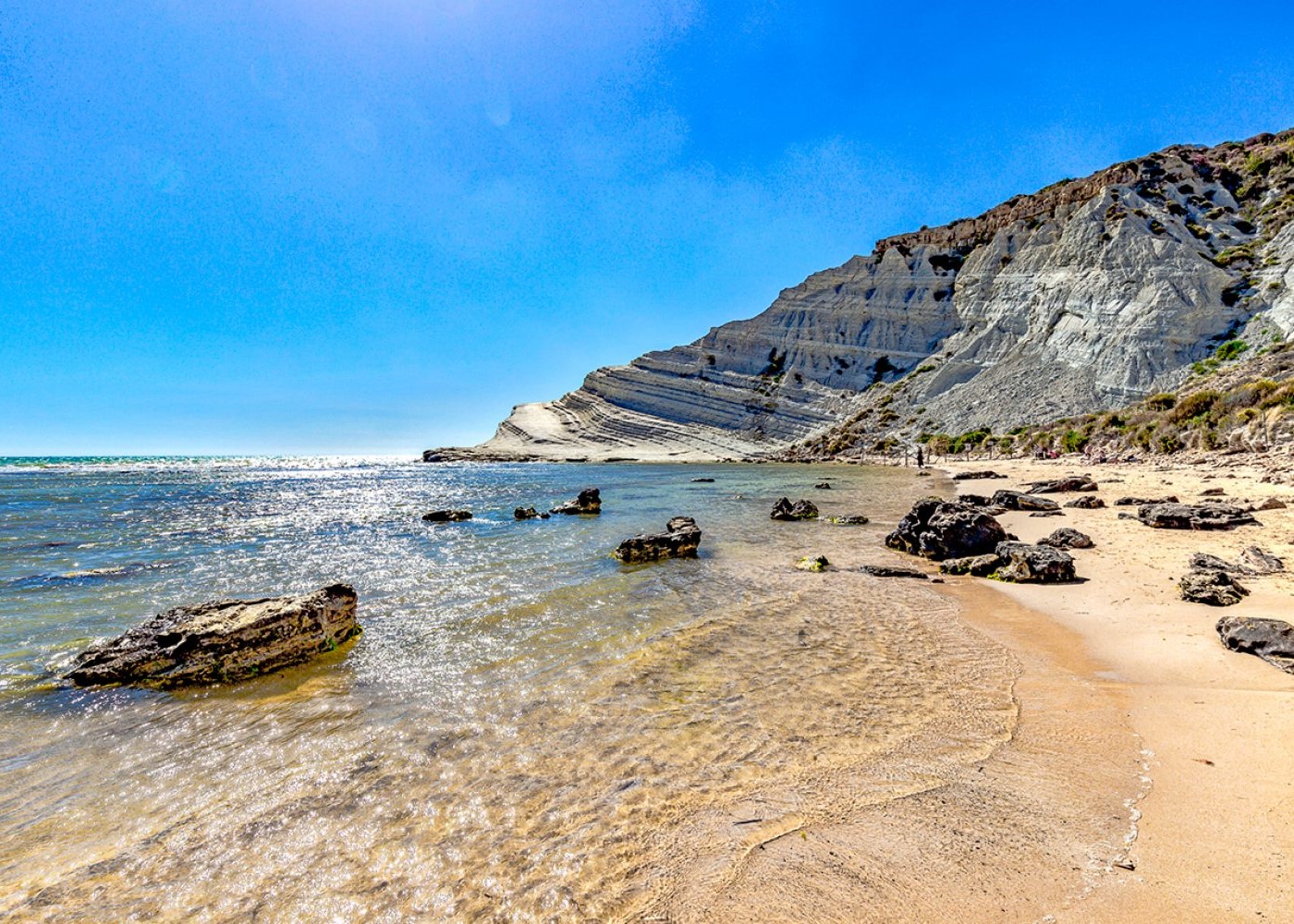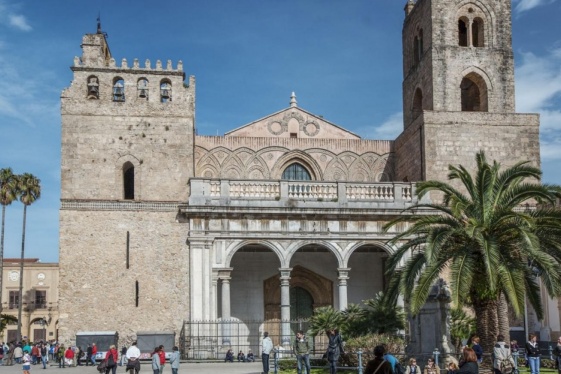

Wild beaches and pristine landscapes surrounded by the scents of Mediterranean vegetation, hidden coasts caressed by a turquoise sea that is just as good as any tropical paradise: from Liguria to Sardinia, from Veneto to Campania, Italy enshrines breathtaking beaches where you can enjoy the sea and feast your eyes with magnificent views. Here for you, fifteen of the most evocative beaches in Italy.
Scala dei Turchi, Sicily. Located between Realmonte and Porto Empedocle, in the Agrigento area, Scala dei Turchi is one of a kind in Italy: it is not a beach but a cliff, a dazzling white cliff, slowly carved by the wind and the sea. According to legend, it was once a shelter for Turkish ships plundering along the Sicilian coast from here. To get to the beach you have to pass along a natural staircase carved into the limestone. All around are sheltered coves.
Cala Luna, Sardinia. It is in the Gulf of Orosei, on the eastern coast of Sardinia, and is one of the most peculiar in the island for its wilderness: Cala Luna is framed by rocky sides and arduous peaks, and dotted with caves, for its crystal clear sea, highly valued for underwater fishing and diving. The golden sandy beach and shallow waters make it suitable for children. You get to the beach only by sea and by tourist boats, or by following an arduous path (for skilled hikers); there are a bar and a restaurant.
The Regina Giovanna Baths, Campania. It is said that here, where there was a villa of the Roman age, between the XIV and XV century came to bathe Queen Joan of Anjou, seduced by the beautiful sea and the suggestive location. The Regina Giovanna Baths are fascinating natural pools at the foot of a cliff in Capo di Sorrento, reachable with a fifteen-minute walk. The seabed is pebbly, the sea immediately deep, but the panorama is exciting: from here, the view ranges from the Gulf of Naples to the Sorrento Peninsula, to Ischia and Procida.
San Fruttuoso Bay, Liguria. It is a small bay nestled between the Ligurian Mountains, between Camogli and Portofino, in the Regional Natural Park of Portofino, with a beautiful turquoise sea - a marine protected area: the small beach of San Fruttuoso is dominated by a 12th century Abbey that bears its name; in its waters, about 17 meters deep, it houses the submerged statue of Christ of the Abyss. The beach is made of pebbles, with a beach resort and rest stops, and can be reached by boat from the nearby places (also from Genoa) or on foot in about two hours, following the paths in the park.
Collelungo Beach, Tuscany. It is quiet and rarely visited and is located in the Maremma Park, among dunes covered with lilies and pine forests: that is the Collelungo Beach, three kilometers of golden sand between Marina di Alberese and the Collelungo Tower. The beach is wide and wild - you could also spot some foxes or herds of cows lying on the beach - and surrounded by sand dunes and the typical Maremma vegetation; the sea is calm and clear. It is accessible from the Visitor Centre along the "A2 Le Torri" route (5.8 km) or from the beach of Marina di Alberese, and then proceeding south for a few kilometers.
Le Dune, Sardinia. A long stretch of white sand dotted with Mediterranean vegetation, between soft sand dunes and a turquoise sea: Le Dune beach (also known as "Is Arenas Biancas") is located in the southwestern tip of Sardinia, in the Teulada area. This natural oasis is home to pink flamingos and egrets, and the sand is broken by lilies and wild rosemary shrubs; a little further north is a lagoon area with ponds.
Punta Aderci, Abruzzo. Long sandy beaches interspersed with pebbles, behind cliffs, pine forests on the sea and hiking trails: Punta Aderci is a nature reserve in the Abruzzo coastal strip of great naturalistic interest. The reserve includes the Punta Penna Beach, a marine amphitheater much appreciated for the clearness of its waters and the unspoiled nature, the Libertini Beach, from which a dirt road leads to the promontory, and the Mottagrossa Beach: this is where one of the wildest and solitary stretches of coast in the Adriatic Sea begins.
Tonnara di Scopello, Sicily. Included in the Vendicari Reserve, a marvelous natural oasis in eastern Sicily, among coastal dunes, saltpans, fresh water ponds and kilometric beaches, the Tonnara Beach - which is among the most beautiful stretches - is a very long sandy coast of unspoiled nature with shallow and turquoise waters. The islet of Vendicari and the remains of the ancient tuna fishery can be enjoyed from the beach, where it is not hard to spot flamingos and cormorants. You can also walk or ride a bicycle along several paths surrounded by vegetation, between watchtowers and ruins of saltpans.
Zagare Bay, Puglia. Located in the Gargano promontory, not far from Mattinata, between high white cliffs overlooking the sea and stacks rising from emerald green waters, the Baia delle Zagare - awarded with the 3 Sails of Legambiente (a well-known environmentalist association) - owes its name to that of the fragrant orange blossoms that bloom nearby. The two stacks of limestone shaped by the wind are distinctive in the Bay. It includes two beaches, divided in two by a cliff: Baia delle Zagare and Baia dei Faraglioni, both of white pebbles. The beaches can be reached by sea or through paths that branch off the main road.
Scialara Beach, Puglia. We are still in the Gargano but this time in Vieste, with its leading beach: the magnificent Scialara Beach is located next to the Pizzomunno, the impressive limestone monolith south of the town of Vieste, the symbol of the city. The beach - also known as "Spiaggia del Castello" because is dominated by a Suevian Castle - is 3 kilometer long, with golden sand, a crystal clear seabed, shallow waters and it is lived up by many beach resorts.
La Fontelina, Campania. One of the most scenic and exclusive beaches in the world, La Fontelina is nestled between the rocks and the sea, where you can take a huge dive in front of the famous Faraglioni. An enchanting place that seems to be created as a film set, the beach was already a place of idleness in Roman times. Wearing beach shoes is a must, but the satisfaction of your senses is assured. Fontelina has been a renowned beach club for years - with sun-beds and beach umbrellas, a bar and a restaurant; you can get there following the little road that begins from the Belvedere di Tragara.
Arco Magno Beach, Calabria. Overlooking the Tyrrhenian Sea not far from Cosenza, in a small inlet between majestic cliffs and a spectacular sea in the Gulf of Policastro, there is a very fascinating beach: the Spiaggia dell'Arco Magno, so called because of the rock arch that separates it from the sea. It is not easy to be reached: it can be accessed by sea, from the nearby Marinella beach, or venturing along an impervious path carved into the rock (from the top of the path, you can enjoy a truly remarkable view).
Porto Caleri Beach, Veneto. It is located in Rosolina, in the Po Delta Park, hidden by the pinewood of a naturalistic oasis, and never crowded: the beach of Porto Caleri is a long sandy beach of six kilometers, wild and rich in species of flora and fauna, where the wind shapes the sand dunes changing the landscape year after year. You can reach the beach through three pedestrian paths along wooden walkways suspended over the water and the vegetation, located inside the Coastal Botanical Garden.
Cala Jannita, Basilicata. A long beach of black sand surrounded by rocks and rocky spurs on the edge of the Illicini Natural Park, Cala Jannita, opposite the islet of Santo Janni, is one of the most famous and scenic beaches in the Maratea area. Awarded with the Blue Flag, the "black beach" is free and accessible on foot from a path that crosses the Mediterranean scrub. The beach is the perfect starting point to visit the nearby Grotta della Sciabella.
Le Fumarole, Campania. A must-see for all those visiting Ischia, Le Fumarole - a few steps away from the village of Sant’Angelo - is a very special beach where the volcanic activity in the island is visible to the naked eye. In ancient times, the "fumaroles", jets of water vapor and gas, and the heat released from the ground were used to heal the body by taking advantage of the benefits of nature. The vapors and bubbles rising from the sand can be seen going underwater with a scuba mask.
You may be interested
-
Davide Gambino è il miglior "Young Italian F...
Si intitola Pietra Pesante, ed è il miglior giovane documentario italiano, a detta della N...
-
Italian American Culture Night
Tuesday, April 14 - 6.30 pm EDTSt. James Church Rocky Hill - 767 Elm St, Rocky Hill,...
-
Lecture and Concert that bring Italy to New...
Saturday, february 28 - 7 pm ESTChrist & Saint Stephen's Church - 120 W 69th St,...
-
Mostaccioli: The Calabrese Christmas Gingerb...
Here in our home, one of our Christmas traditions is making gingerbread cookies and one gi...
-
Pavarotti. Il mondo di Big Luciano. Anteprim...
Il mondo di Luciano Pavarotti e la sua grande carriera di cantante lirico rivivranno il 23...
-
''La Gente di Mulberry Street'' presentato a...
Valsinni- Italia, terra di emigranti. Presentato a Valsinni il nuovo saggio storico di Raf...
-
'A beacon of hope': Sicily’s enduring North A...
On a late summer evening in the Sicilian seaside village of San Vito Lo Capo, Anna Grazian...
-
'A Ziarella va in America: tournèe in Arizona...
‘A Ziarella va in America. Non è un titolo da film, ma una piacevole realtà. Il...










